
Amazing Ants Game
For most of us, ants may all look essentially the
same—tiny, nondescript creatures that scurry around
carrying things twice their size. But there are nearly 10,000
known species, each the unique product of over 140 million
years of evolution. And their behaviors are just as diverse.
Below, meet eight different types of ants with extraordinary
habits and abilities.—Melissa Salpietra
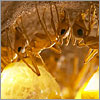

|
|
Honey pot ant
Genus: Myrmecocystus
Honey pot ants have a unique means of surviving in the
deserts where they live—they store excess food in
the bodies of some of their workers. Honey pot workers
gather food just like any other ant, seeking out plant
nectar, honeydew from aphids, and similar sweet treats.
But when they return to the nest, these workers feed
their spoils to a specialized class of workers called
repletes. The repletes store the food in their gasters,
the hindmost section of their bodies, which have thin,
flexible walls that can distend to great volume. When
food is scarce, the repletes simply regurgitate the
stored food and feed the colony.
|
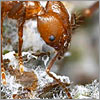

|
|
Leafcutter ants
Genus: Atta or
Acromyrmex
Although their common name suggests that leafcutter ants
live off of leaves, they don't eat them. The ants
scissor off pieces of fresh leaves using their sharp
mandibles and carry them back to their nest, where
smaller workers chew up the leaves and make a mixture
that includes some of their own feces. On this bed of
vegetable fertilizer, the ants cultivate a certain kind
of fungus. Found only within ant colonies, this fungus
feeds the leafcutters, which in turn ensure the fungus's
survival. When a new leafcutter queen sets off to start
her own colony, she brings along a starter-culture of
the fungus.
|
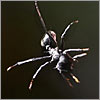

|
|
Gliding ant
Genus: Cephalotes
Living in the forest canopy, gliding ants nest within
tree cavities. If one falls accidentally or jumps off
its host tree to avoid a predator, it can actually steer
itself through the air. In mid-fall, the wingless ant
orients itself so that its abdomen and hind legs point
toward the tree from which it fell. It can even make
180-degree turns in mid-air. "Controlled aerial
descent," as it is known, ensures the ant won't fall too
far from its nest and become lost.
|
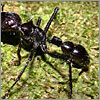

|
|
Bullet ant
Species:
Paraponera clavata
Think honeybees and paper wasps have a painful sting?
This ant has a jab that produces debilitating pain that
can last up to 24 hours. P. clavata uses its
powerful sting not only as a defensive mechanism if
threatened but also as a weapon while foraging. The
indigenous Sateré-Mawé people of Brazil
use bullet ants in a painful initiation ritual, in which
youths on the brink of manhood repeatedly don
hand-woven gloves laced with dozens of live
bullet ants.
|


|
|
Trap-jaw ant
Genus: Odontomachus
This ant's bite is literally faster than a speeding
bullet. The trap-jaw ant, a stealthy hunter, stalks its
prey with its formidable mandibles wide open. When tiny
hairs protruding from its jaw come in contact with its
victim, the ant's mandibles snap shut in under a
millisecond. The lightning-fast jaws also serve another
purpose. If closed on a hard, flat surface, they can
actually catapult the ant through the air, a technique
the trap-jaw uses to cross enemy lines.
|
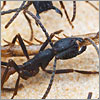

|
|
Army ant
Genus: Eciton
Unlike most ants, which make long-term nests, army ants
are migratory. They build temporary camps, or bivouacs,
out of their own bodies. Using hooks at the end of their
legs, worker ants link their legs together and create
ant chains. These chains layered upon each other create
a huge mass of ants, with the queen and larvae safely in
the center. Army ants exhibit group predation and go on
leaderless raids, swarming anything in their path. Not
much stands a chance against these ants, unless it can
move out of the way—the swarm averages a foot per
minute. Even large mammals can fall prey to it if they
are injured, tied up, or otherwise immobile.
|
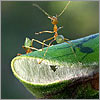

|
|
Weaver ant
Genus: Oecophylla
These arboreal ants exhibit extraordinary teamwork while
building their nests; even the larvae get to pitch in.
Weaver ants make their nests in treetops by "stitching"
leaves together. They begin by forming a chain using
their bodies that stretches from one edge of a leaf to
the other. As ants exit the chain one at a time, the
leaf edges come together. Workers then select larvae of
a certain age and carry them to the construction site.
Each worker holds a larva in its mandibles and gently
squeezes, signaling the larva to expel threads of silk.
The worker moves the larva back and forth over the
touching edges of each leaf, and like glue, the silk
binds the leaf together.
|
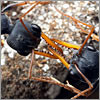

|
|
Jack jumper ant
Species:
Myrmecia pilosula
Known as the tigers of the ant world, jack jumper ants
are aggressive and potentially deadly, killing on
average one person every four years in Tasmania. Their
sting releases venom that, in some people, can cause
anaphylaxis, a life-threatening allergic reaction.
Australia has about 90 different species of bulldog ant,
as Myrmecia ants are known commonly, and all are
armed with powerful stingers. But in Tasmania it is
M. pilosula that poses the most significant
threat, because it is common in suburban areas, and
Tasmanians love being outdoors.

|
|


We recommend you visit the
interactive version. The text to the left is provided for printing purposes.
|









